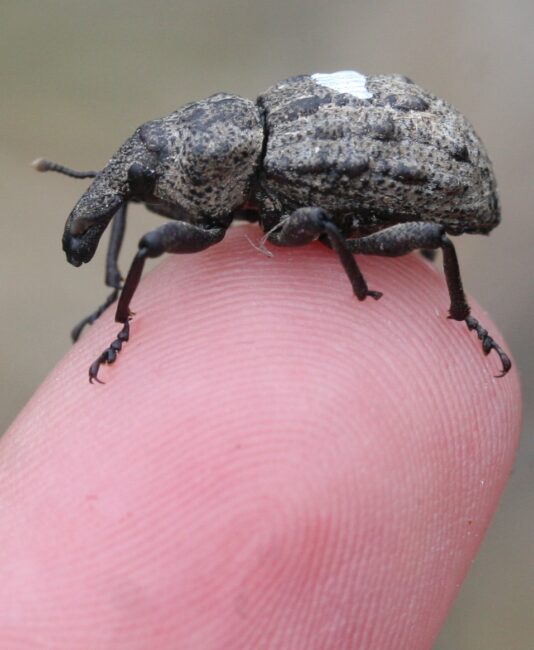Can the Canterbury knobbled weevil claw its way back from extinction?
If you are small, grey, and have more than four legs, you probably don’t receive much attention from humans. If your species has many large and healthy populations this shouldn’t matter, but what if there are fewer than a hundred of you clinging to existence in a single tiny nature reserve?
The Canterbury knobbled weevil is in dire straits: there are probably fewer than 76 individuals left on the planet1. Presumed extinct in the 1990s (and still listed as such by the IUCN2), the weevil was rediscovered in 2004 at Burkes Pass, a 12.4 hectare reserve in New Zealand3. The Burkes Pass population of weevils is probably the only population left, and every individual is precious.
The knobbled weevil’s return from oblivion attracted some attention from scientists, notably Emily Fountain who studied the weevil for her PhD. Collecting data on a critically endangered invertebrate was a challenge: you can’t stick a radio collar on a weevil, and grinding a few up to get DNA would remove a significant percentage of the population.
Emily caught weevils, using live pitfall traps, and painted ID numbers on their elytra (wing cases). Each weevil that was trapped had a tiny piece of its tarsus (at the very end of a leg) removed for DNA analysis. Over three years, sufficient data were collected to indicate that the weevil population is declining at an alarming rate, but the sex ratios are roughly even. There is hope that the species will recover, with help from conservationists.
Humans are naturally drawn towards conserving large, attractive animals such as tigers (which, by the way, number around 3,000 4). Small animals like weevils are easily overlooked, and can fade out of existence. At least the knobbled weevil, though standing on the edge of extinction, has found a couple of friends to fight its corner.
References
- Fountain, E. D., Wiseman, B. H., Cruickshank, R. H., & Paterson, A. M. (2013). The ecology and conservation of Hadramphus tuberculatus (Pascoe 1877) (Coleoptera: Curculionidae: Molytinae). Journal of Insect Conservation.
- World Conservation Monitoring Centre 1996. Karocolens tuberculatus. In: IUCN 2012. IUCN Red List of Threatened Species. Version 2012.2.
- Young, L. M., Marris, J. W. M., & Pawson, S. M. (2008). Back from extinction: Rediscovery of the Canterbury knobbled weevil Hadramphus tuberculatus (Pascoe 1877) (Coleoptera: Curculionidae), with a review of its historical distribution. New Zealand Journal of Zoology, 35, 323–330. doi:10.1080/03014220809510129
- Chundawat, R.S., Habib, B., Karanth, U., Kawanishi, K., Ahmad Khan, J., Lynam, T., Miquelle, D., Nyhus, P., Sunarto, S., Tilson, R. & Sonam Wang 2011. Panthera tigris. In: IUCN 2012. IUCN Red List of Threatened Species. Version 2012.2.

